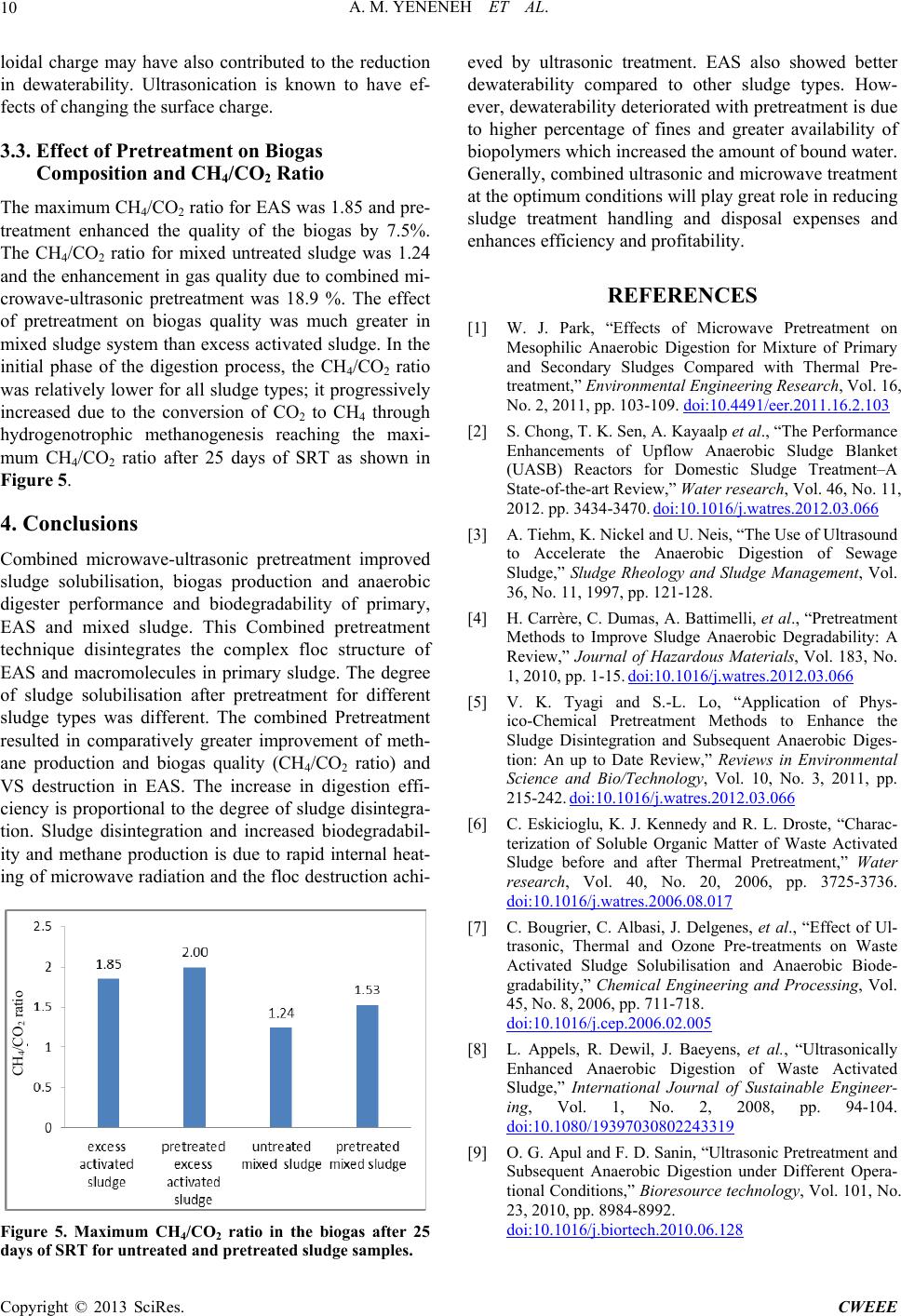
A. M. YENENEH ET AL.
10
loidon
3.3. Effect of Pretreatment on Biogas
Th e ma4 21.85 and pre-
ve-ultrasonic pretreatment improve
al charge may have also contributed to the reducti
in dewaterability. Ultrasonication is known to have ef-
fects of changing the surface charge.
Composition and CH4/CO2 Ratio
xi mum C H/CO ratio for EAS was
treatment enhanced the quality of the biogas by 7.5%.
The CH4/CO2 ratio for mixed untreated sludge was 1.24
and the enhancement in gas quality due to combined mi-
crowave-ultrasonic pretreatment was 18.9 %. The effect
of pretreatment on biogas quality was much greater in
mixed sludge system than excess activated sludge. In the
initial phase of the digestion process, the CH4/CO2 ratio
was relatively lower for all sludge types; it progressively
increased due to the conversion of CO2 to CH4 through
hydrogenotrophic methanogenesis reaching the maxi-
mum CH4/CO2 ratio after 25 days of SRT as shown in
Figure 5.
4. Conclusions
Combined microwad
sludge solubilisation, biogas production and anaerobic
digester performance and biodegradability of primary,
EAS and mixed sludge. This Combined pretreatment
technique disintegrates the complex floc structure of
EAS and macromolecules in primary sludge. The degree
of sludge solubilisation after pretreatment for different
sludge types was different. The combined Pretreatment
resulted in comparatively greater improvement of meth-
ane production and biogas quality (CH4/CO2 ratio) and
VS destruction in EAS. The increase in digestion effi-
ciency is proportional to the degree of sludge disintegra-
tion. Sludge disintegration and increased biodegradabil-
ity and methane production is due to rapid internal heat-
ing of microwave radiation and the floc destruction achi-
CH
4
/CO
2
ratio
eved by ultrasonic treatment. EAS also showed better
dewaterability compared to other sludge types. How-
ever, dewaterability deteriorated with pretreatment is due
to higher percentage of fines and greater availability of
biopolymers which increased the amount of bound water.
Generally, combined ultrasonic and microwave treatment
at the optimum cond itions will play great role in reducing
sludge treatment handling and disposal expenses and
enhances efficiency and profitability.
REFERENCES
Figure 5. Maximum CH4/CO2 ratio in the biogas after 25
days of SRT for untreated and pretr e ated sludge samples.
[1] W. J. Park, Pretreatment on
Mesophilic Aixture of Primary
“Effects of Microwave
naerobic Digestion for M
and Secondary Sludges Compared with Thermal Pre-
treatment,” Environmental Engineering Research, Vol. 16,
No. 2, 2011, pp. 103-109. doi:10.4491/eer.2011.16.2.103
[2] S. Chong, T. K. Sen, A. Kayaalp et al., “The Performance
Enhancements of Upflow Anaerobic Sludge Blanket
(UASB) Reactors for Domestic Sludge Treatment–A
State-of-the-art Review,” Water research, Vol. 46, No. 11,
2012. pp. 3434-3470. doi:10.1016/j.watres.2012.03.066
[3] A. Tiehm, K. Nickel and U. Neis, “The Use of Ultrasound
to Accelerate the Anaerobic Digestion of Sewage
aerobic Degradability: A
Sludge,” Sludge Rheology and Sludge Management, Vol.
36, No. 11, 1997, pp. 121-128.
[4] H. Carrère, C. Dumas, A. Battimelli, et al., “Pretreatment
Methods to Improve Sludge An
Review,” Journal of Hazardous Materials, Vol. 183, No.
1, 2010, pp. 1-15. doi:10.1016/j.watres.2012.03.066
[5] V. K. Tyagi and S.-L. Lo, “Application of Phys-
ico-Chemical Pretreatment Methods to Enhance the
Sludge Disintegration and Subsequent Anaerobic Diges-
tion: An up to Date Review,” Reviews in Environmental
Science and Bio/Technology, Vol. 10, No. 3, 2011, pp.
215-242. doi:10.1016/j.watres.2012.03.066
[6] C. Eskicioglu, K. J. Kennedy and R. L. Droste, “Charac-
terization of Soluble Organic Matter of Waste Activated
Sludge before and after Thermal Pretreatment,” Water
research, Vol. 40, No. 20, 2006, pp. 3725-3736.
doi:10.1016/j.watres.2006.08.017
[7] C. Bougrier, C. Albasi, J. Delgenes, et al., “Effect of Ul-
trasonic, Thermal and Ozone Pre-treatments on Waste
Activated Sludge Solubilisation and Anaerobic Biode-
gradability,” Chemical Engineering and Processing, Vol.
45, No. 8, 2006, pp. 711-718.
doi:10.1016/j.cep.2006.02.005
[8] L. Appels, R. Dewil, J. Baeye
Enhanced Anaerobic Digestio
ns, et al., “Ultrasonically
n of Waste Activated
Sludge,” International Journal of Sustainable Engineer-
ing, Vol. 1, No. 2, 2008, pp. 94-104.
doi:10.1080/19397030802243319
[9] O. G. Apul and F. D. Sanin, “Ultrasonic Pretreatment and
Subsequent Anaerobic Digestion under Different Opera-
tional Conditions,” Bioresource technology, Vol. 101, No.
23, 2010, pp. 8984-8992.
doi:10.1016/j.biortech.2010.06.128
Copyright © 2013 SciRes. CWEEE